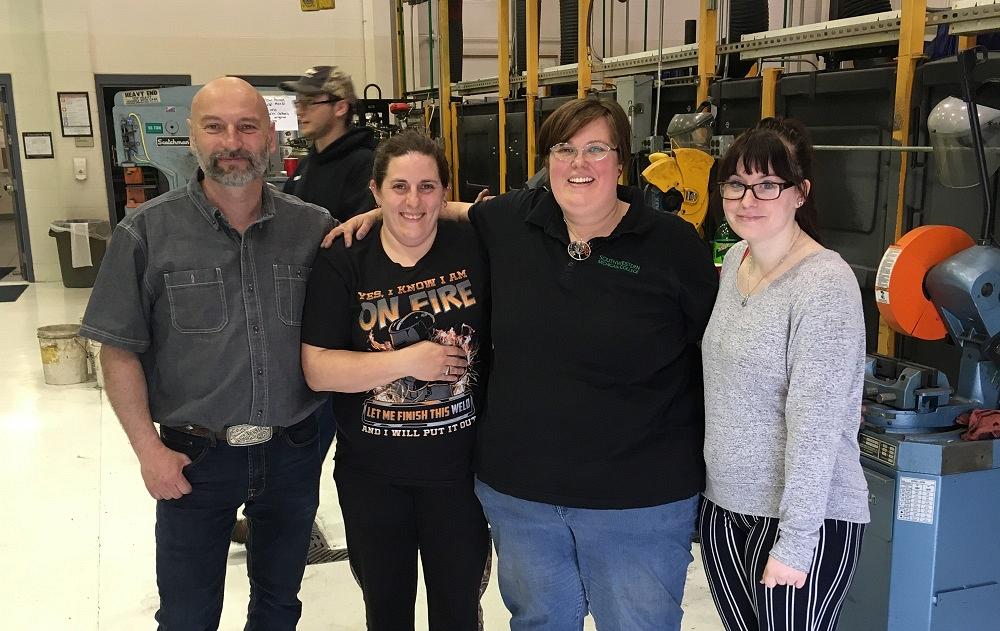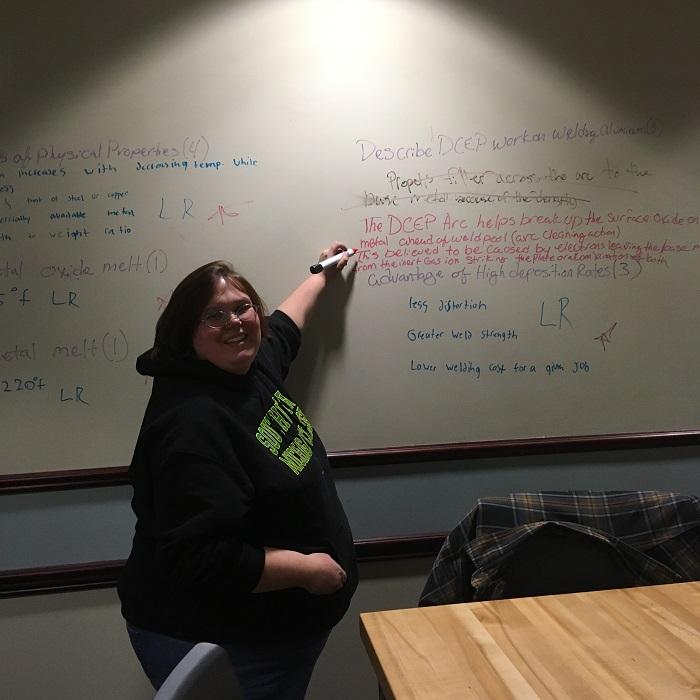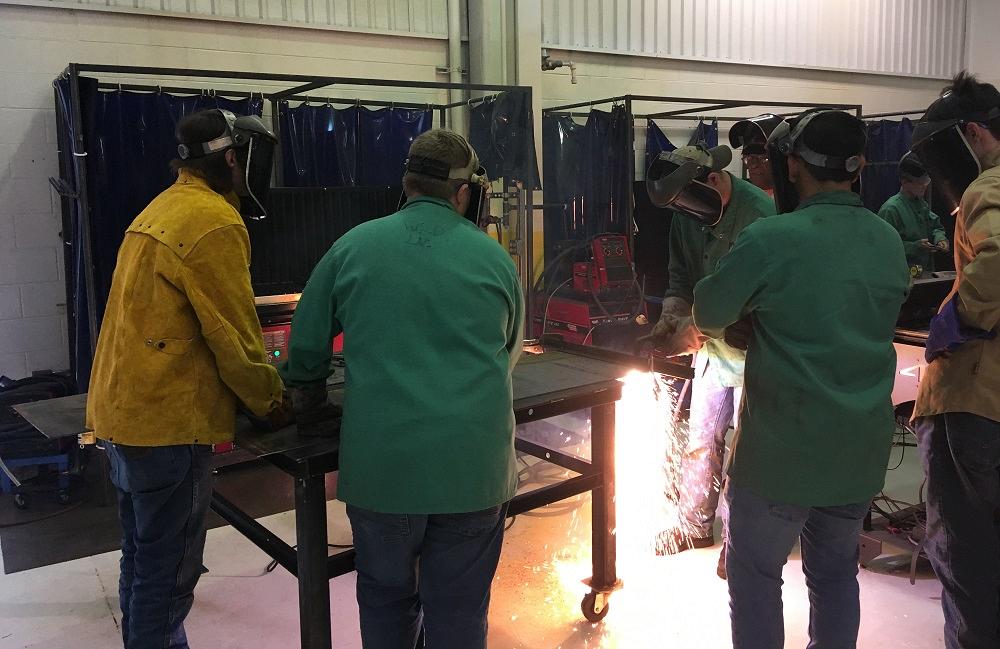- FMA
- The Fabricator
- FABTECH
- Canadian Metalworking
Categories
- Additive Manufacturing
- Aluminum Welding
- Arc Welding
- Assembly and Joining
- Automation and Robotics
- Bending and Forming
- Consumables
- Cutting and Weld Prep
- Electric Vehicles
- En Español
- Finishing
- Hydroforming
- Laser Cutting
- Laser Welding
- Machining
- Manufacturing Software
- Materials Handling
- Metals/Materials
- Oxyfuel Cutting
- Plasma Cutting
- Power Tools
- Punching and Other Holemaking
- Roll Forming
- Safety
- Sawing
- Shearing
- Shop Management
- Testing and Measuring
- Tube and Pipe Fabrication
- Tube and Pipe Production
- Waterjet Cutting
Industry Directory
Webcasts
Podcasts
FAB 40
Advertise
Subscribe
Account Login
Search
Still Building America: Michigan welding instructor thankful to stumble into teaching
Allyson Starrett of Southwestern Michigan College teaches a wide age range of welding students
- By Darla Welton and Josh Welton
- March 28, 2020

Allyson Starrett (second from right), a welding instructor at Southwestern Michigan College, with some of her students Image provided by Allyson Starrett
I became acquainted with welding teacher Allyson Starrett through a welding group on social media. Wanting to hear more about her work, Josh and I invited her to our home while she was visiting another trade school in the Detroit area. Allyson is a dedicated teacher and a true advocate for the trade, as well as for her students who range in age from 16 to 45.
Darla Welton: Please explain what kind of work you do and how you got started.
Allyson Starrett: I am one of the head welding instructors at Southwestern Michigan College, working around the clock and teaching 10 classes this semester. I’ve brought evening adult education offerings back into our trades program and I hope to continually make it more appealing to younger students too.
I stumbled into teaching.
I wanted to become a welder when I was in high school. My freshman through junior years I took tech classes including CAD. However, by my senior year I realized that I didn’t want to be in drafting any longer so I went to my drafting teacher and said that I wanted to go into welding. That teacher - a woman - told me that women should be drafters and not welders. That set me back many years. I was in a weird place at 17 and just took her words to heart.
So when I left high school I started a social working degree, and then an occupational therapy degree - I tried the medical degrees and I realized my brain was not wired for it. I would study eight to 10 hours for anatomy and physiology and it would all fall out of my brain. All the while I worked dead-end customer service jobs and assembly jobs in factories. Even when I made line lead in the factory, I watched my male co-workers with no welding experience get pushed up to the welding floor, but not me.
I finally decided to go back to school for welding at 26 years old. I was working in home-care, caring for elderly people, while I was going to school for welding. The biggest lightbulb clicked on for me and I realized that I had been chasing so many other things, when welding was what I had always wanted to do.
I was one of the only females in my program but became the top welding student at Southwestern Michigan College. I ended up teaching a lot of students around me when it came to theory stuff and they helped me a lot in the booth, where I struggled. I worked my tuchus off in the booth. I was like a fungus at that point - in the lab from when it opened until it closed, taking every chance to be in there. After graduating I took a job in a trailer factory; it was not the greatest place for a welder to be, but it was the industry in the area. While working there a position opened up at Southwestern Michigan College for teaching welding to high school students, and I have been doing it for six years now. I didn’t have a lot of time to prep because I was hired a few days into the first semester, so I had to hit the ground running while trying to figure it all out!
DW: Who were your influences, and who has impacted your life?
AS: I’ll be honest, your husband was one of them! When I started getting into welding, we had to do research papers and I chose to focus on artistic welding. That’s when I stumbled upon Josh [Welton]. So I’ve been a fan since the beginning of my career.
My mom has always been a big supporter of anything that I’ve done. And I was always around my dad when he would be working on cars as a kid. I had some mechanical influences from him.
Nate Kramb and Mike Chaddock were phenomenal welding instructors for me.
Also, the Rosie the Riveter women! I am truly grateful that women during World War II left their homes to work in the factories to help build whatever the country needed, including Naval ships. That was a huge moment for women to start to break that glass ceiling of the trades. Many went back to working in homes after the war was over, but there were some that stayed in the trades. They kept the passion and helped open the door for many of us women in trades. I am grateful for that moment in history for us.
DW: What is your favorite part of the job?
AS: Interacting with and working with my students is so rewarding. I love seeing the lightbulbs come on as they get it and grow in the field! It makes it all worth it. I had a student last year who aged out of the foster system. When she graduated, I helped her find a good job and now she has her own house and a car. It warms my heart to know that she is doing well and has found stability.
Teaching kids and making an impact on their lives and their future is the best.
I do Boy Scout welding merit badge fairs too. One is coming up in a few weeks. I also hold welding summer camps for sixth- to ninth- graders. I am a firm believer that if you get kids interested during those years, you can get them hooked. And especially with girls in STEM - if you don’t interest them by eighth grade, you will lose them. It’s important that kids who want to get their hands dirty are given the opportunity to explore trades at that age. And I hate hearing stories of counselors steering “smart kids” away from trades programs and into AP classes. Give them a chance if they are interested.
I also do First Robotics judging for high school students. The competitions are amazing because the kids design and build their robots and they are required to lay out business plans too. I judge the mechanical side. I love talking to the kids about how they approached their design and learning about how hands-on they are in the process.
I have an open-door policy for any student that ever comes into my classroom. Many of my students text me on the weekends if they need help with anything, even if they just need some consumables for practice.
DW: Do you have a favorite project that you have worked on?

Allyson Starrett sitting in the Flame Tech torch throne at FABTECH 2019 in Chicago. Image provided by Allyson Starrett
AS: My favorite project is a brightly colored peacock that I made a few years ago. We didn’t have any art in our building at all, but the school invited us to participate in a teacher/artist display. I brought it in and they built me a podium to put it on. It’s made out of all recycled parts. For the first two years that I taught, I was actually in the high school and had zero budget for metal. So it was a lot of days of digging through company scrap bins to find materials for my students. And I found a few remnants for myself too.
DW: What is the most challenging part of your job?
AS: Advocating for welding right where I am is a challenge. The administration doesn’t truly understand what welding is and how important it is for our world. I’m the front-end person. My co-worker handles the lab maintenance and I deal with all of the meetings, emails, and paperwork.
My college tried to cut our welding program from the STEM day being held on campus. I wasn’t invited, but the robotics teacher let me know about it. I questioned why the welding program wasn’t included and was told “it’s more for STEM-related fields.”
How is welding not STEM? We do science, technology, engineering, and mathematics every single day. And throw in the arts - we are STEAM too!
We do our own marketing, promotions, and recruiting for our programs.
DW: Have you faced any specific challenges as a woman in the industry?
AS: When I go to FABTECH with my co-worker, he is the first person that anyone talks to, never me. Even when our maintenance guys come into the shop, they want to talk to my male co-worker instead of me. It’s a bit infuriating, but I keep pushing and proving that I can hold my own in this industry.
DW: What's your future career goal?
AS: As a female welding instructor I hope to get more women in the trades. I also want to use every ounce of my passion for the trade to influence and educate at many levels. I never would have thought that I’d get into teaching when I was in high school. I will continue recruiting at the middle school level to capture the attention of kids who will succeed in trades. I have kids in my classes who say, “This is the smartest I have ever felt.” They have actually had people tell them that they are dumb and have made them feel worthless. But I love the quote that says, “If you judge a fish by its ability to climb a tree, it will live its whole life believing that it is stupid.”

Allyson Starrett teaching in her Southwestern Michigan College classroom. Image provided by Allyson Starrett
I’d love to run apprenticeship programs for larger corporations that want to pay to educate welders. I’m also going for my CWI certification this year.
DW: I feel like teachers always have a phrase that they like to repeat to their students. What would your students say is your phrase?
AS: I push full penetration on their groove welds. If they don’t have full penetration, I reject it. It’s about getting them to understand quality and why it’s so important. So I’ll look at their weld and ask, “Would you trust that weld on your grandma’s hot water heater?” Most of the time they know what that means, so they say, “noooo,” and walk back to try again. Sometimes they’ll say, “I don’t care.” I wonder if those kids didn’t get enough of grandma’s cookies or birthday checks!
(At this point in the conversation, Josh chimed in to say, “That’s how you weed out the sociopaths from the good welders!”)
DW: What advice would you give to someone pursuing a welding career?
AS: With welding if you put in minimal work then you’ll probably just be in a factory slinging some wire, but if you want more and work hard for it, then you’ll get more out of it. You are never done learning, and if you think that you are, you will never grow or move forward. The opportunities are endless. Check out robotics or check out the union locals - look into cross training and apprenticeships after graduating. I encourage moving too. I live in an area where the Elkhart area RV/trailer factories have killed the wages for a lot of welders. I’m always hungry for more and I teach my students that they should be too.
DW: How is your program handling classes with the college being closed due to the COVID-19 Shelter at Home mandate in Michigan?
AS: On March 12 there was a meeting at the college about moving classes online and restricting as much face-to-face time as we could. I fought to keep some labs open so our graduating students could finish up their projects. I set up a schedule for those students, broken up into two-hour labs with a max of five students. However, eventually the college made the call that really no one should be working in the building, so the labs were shut down. The rest of our classes went online, and we gave them lectu Shelter at Home was put into action in the state of Michiganres to go over as well as tests. It’s hard trying to bring a hands-on program online. I have a few students that have their own little welding workshop at home, so I sent them a bunch of material and electrodes so they can get some practice time logged. We hope to start classes up on April 13, but we are prepping to put finals online.
Check out more of the Still Building America series with stories and interviews from metal fabricators, welders, and small-business entrepreneurs.
subscribe now

The Welder, formerly known as Practical Welding Today, is a showcase of the real people who make the products we use and work with every day. This magazine has served the welding community in North America well for more than 20 years.
start your free subscriptionAbout the Authors

Josh Welton
Owner, Brown Dog Welding
(586) 258-8255
About the Publication
- Stay connected from anywhere

Easily access valuable industry resources now with full access to the digital edition of The Fabricator.

Easily access valuable industry resources now with full access to the digital edition of The Welder.

Easily access valuable industry resources now with full access to the digital edition of The Tube and Pipe Journal.
- Podcasting
- Podcast:
- The Fabricator Podcast
- Published:
- 04/16/2024
- Running Time:
- 63:29
In this episode of The Fabricator Podcast, Caleb Chamberlain, co-founder and CEO of OSH Cut, discusses his company’s...
- Trending Articles
Sheffield Forgemasters makes global leap in welding technology

ESAB unveils Texas facility renovation

Engine-driven welding machines include integrated air compressors

How welders can stay safe during grinding

The impact of sine and square waves in aluminum AC welding, Part I

- Industry Events
16th Annual Safety Conference
- April 30 - May 1, 2024
- Elgin,
Pipe and Tube Conference
- May 21 - 22, 2024
- Omaha, NE
World-Class Roll Forming Workshop
- June 5 - 6, 2024
- Louisville, KY
Advanced Laser Application Workshop
- June 25 - 27, 2024
- Novi, MI





























